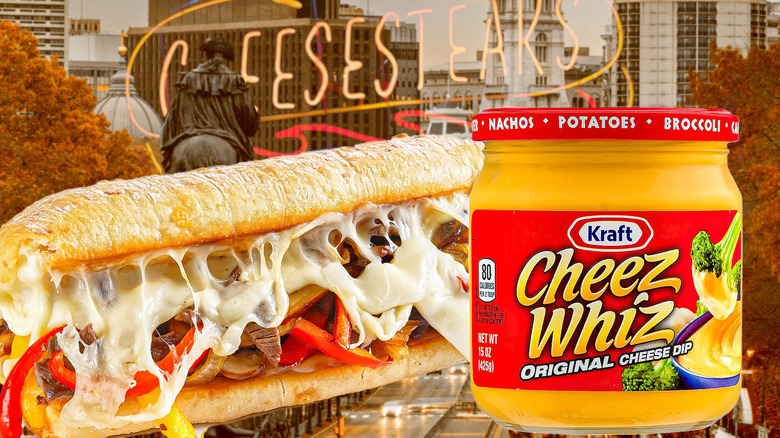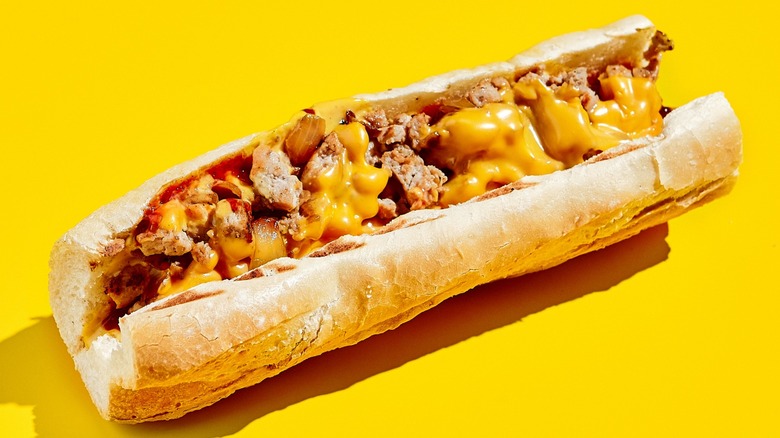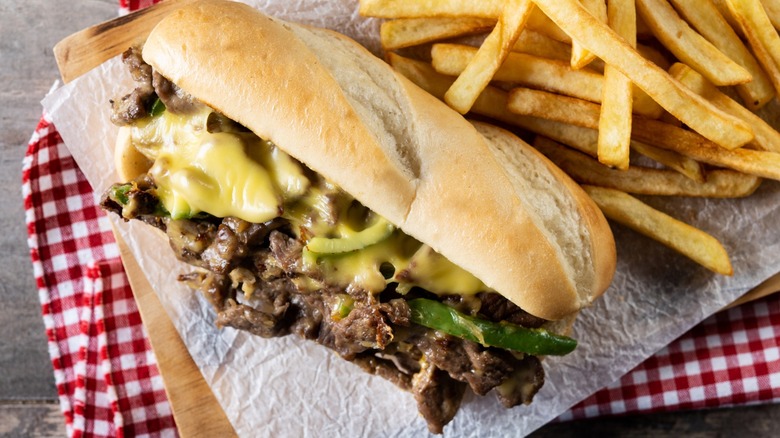Does A Philly Cheesesteak Need To Have Whiz? The Truth Behind The Myth
Regional dishes are as telling of an area's culture as the people who live there. Chicago has the Italian beef, Cincinnati has its chili, and Philadelphia has the Philly cheesesteak. This classic sandwich is famous across America for its thinly chopped steak, crusty baguette, grilled onions – and a heated debate about whether or not a real Philly cheesesteak includes bright yellow Cheez Whiz. Many locations across the city include the artificial cheese sauce in their rendition of the sandwich, with some going so far as to claim it's not an authentic cheesesteak if it doesn't have Whiz on it.
Cheez Whiz isn't the only dairy option for cheesesteaks in Philly — other common cheeses used include provolone and American cheese. Still, most people are familiar with the iconic image of a Philly cheesesteak smothered in gooey Cheez Whiz, which is strange considering that the original cheesesteak didn't even have cheese on it at all. And, when it was finally introduced to the sandwich, provolone was the original cheese of choice. So, how exactly did Cheez Whiz become so synonymous with Philly cheesesteaks?
How Cheez Whiz became the dominant cheese for cheesesteaks
Cheez Whiz first came into existence in 1952, and, surprisingly, it didn't debut in America. The first iteration of Cheez Whiz was released by Kraft to Great Britain and was meant to serve as a mild type of cheese for British dishes. Cheez Whiz was then released in America a year later in 1953. By the time the bright yellow cheese was sold on American shelves, provolone was already the cheese of choice on cheesesteaks.
The reason Cheez Whiz became a key component of the sandwich was not because of taste or mouthfeel, but simply because of ease. Frank Olivieri, the nephew of the original cheesesteak creator Pat Olivieri, revealed in a 1985 interview with The New York Times that the real reason his uncle chose Cheez Whiz (and why so many other shops opted for it as well) was because it was easy to apply. The artificial cheese spread melted down quickly and its liquid texture was ideal for slathering a sandwich with.
No longer would sandwich makers have to wait for slices of cheese to melt to the proper texture, which meant faster production and more sandwiches in the hands of people all over Philadelphia. The initial use of Cheez Whiz was ultimately a business decision more than anything else. The fact that people loved the drippy, salty cheese was just a happy coincidence.
The history of the Philly cheesesteak
The first Philly cheesesteak was made by Pat Olivieri at his shop, Pat's King of Steaks, around 1930. According to the Pat's King of Steaks website, the legend goes that one day Pat Olivieri was tired of the typical lunch he would have at his hot dog stand. So, he purchased some chopped meat and cooked the cut beef alongside the hot dogs at his stand. He then put the meat on an Italian roll, added some thinly sliced grilled onions, and the iconic sandwich was born.
It began its domination of the Philadelphia food scene when a taxi driver spotted Olivieri eating the sandwich and asked for one himself. Its popularity increased from there, and Olivieri soon ditched the hot dogs in favor of the sandwich. Then, in the 1940s, the chopped steak sandwich morphed into its second version and earned the famous name everyone knows today. This was when restaurants first began adding slices of provolone cheese to the sandwich, offering a welcomed creamy, melty texture that previous iterations had been missing.
And, thus, the official Philly cheesesteak came to be. It's debated whether Olivieri was the first to add cheese, or if Joe Vento, the founder of a rival shop called Geno's, beat him to it. After the introduction of Cheez Whiz in America in 1953, the Philly cheesesteak was forever changed again, and now you'd be hard-pressed to find a location in Philadelphia that doesn't offer the gooey cheese spread as a main option.


